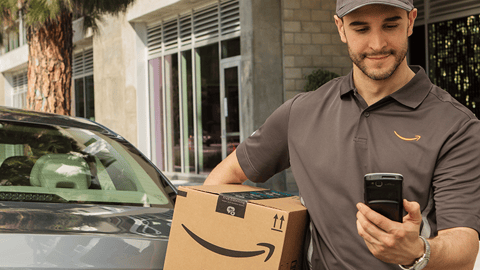Inside Amazon's New Grocery Store
We now know what the inside of Amazon's first traditional supermarket looks like, and it looks like a traditional supermarket, but built for the digital age.
Bloomberg gained access to the new Amazon grocery store being built at 6245 Topanga Canyon Blvd. in Woodland Hills, Calif. Bloomberg photos show numbered aisles, coolers, a meat and seafood counter and a “Fresh Kitchen” for prepared foods and soups filling the 33,000 square foot space.
According to Bloomberg, the center store features aisles of conventional shelves with the digital tags the company uses in its Amazon Go, Amazon Books and 4-Star stores. Other digital flourishes include flatscreen TVs throughout the store and a pickup window for order pickup and customer returns.
Other sites Amazon is said to have leased in the Los Angeles area suggest a preference for repurposing existing storefronts, rather than building new ones, according to Bloomberg. The company has leased a former Ralphs supermarket in the Los Angeles neighborhood of Encino. In Irvine, Amazon is renovating a former Babies “R” Us and last month applied for a liquor license for the space under the name “Amazon Fresh,” the same name as the company’s grocery delivery service. And in Thousand Oaks, Amazon has locked up space formerly occupied by a boutique grocer founded by Paige Laurie, a grandniece of Walmart Inc. founder Sam Walton, according to Bloomberg.
Additionally, Amazon is scouting store sites in other markets across the country and reportedly has pinpointed locations in suburban Chicago.
It remains to be seen how Amazon will expand its distribution capacity to supply a new, more mainstream-focused food retail concept with hundreds or thousands of locations and a different assortment from the Whole Foods supply chain. The company has not said whether it will build a new network of food distribution centers.
Meanwhile, Amazon has expanded its chain of Amazon Go stores to 25 locations in major U.S. cities and will soon open a larger, 10,000-square-foot version in Seattle, where Amazon employees have been test-shopping, Bloomberg reports.
Seattle-based Amazon.com Inc. reported fourth-quarter profit late last month of $3.3 billion (a 7% increase), or $6.47 a share, on record sales of $87.4 billion (up 21%), after reporting a profit of $6.04 a share on sales of $72.38 billion in the prior-year period. Even more notable was the company’s reported operating income of $3.9 billion (up 3%), which smashed Wall Street analysts’ forecasts by about 44%.
The results were impressive considering that during the previous quarter, Amazon warned that $1.5 billion of investments in faster shipping times would weigh on its holiday quarter earnings. Instead, those investments paid off in the way of “record-breaking holiday sales” and an earnings report that catapulted shares of the ecommerce behemoth’s stock over a $1 trillion valuation as of Friday morning. Amazon shares were marked 8.8% higher in pre-market trading this morning to indicate an opening bell price of $2,042.51 each, the highest since Sept. 4.
Amazon is now the third-largest company in the S&P 500 by annual revenue.
Amazon’s investments in shipping are also netting the company more Prime members, which topped 150 million in the fourth quarter.
“That is what we’re seeing — it’s not anything sudden, but the progress on a long-term strategy of ours,” Amazon CFO Brian Olsavsky said late Thursday during a fourth-quarter earnings call.
Amazon watchers might remember that it was only two years ago that the company surpassed 100 million Prime members. The company is attempting to expand its one-day delivery option for Amazon Prime members to more than 100 million products.
“Prime membership continues to get better for customers year after year,” Amazon CEO Jeff Bezos said. “And customers are responding — more people joined Prime this quarter than ever before. We’ve made Prime delivery faster — the number of items delivered to U.S. customers with Prime’s free one-day and same-day delivery more than quadrupled this quarter compared to last year.”
Meanwhile, Prime members in more than 2,000 U.S. cities and towns can now access free two-hour grocery delivery from Amazon Fresh and Whole Foods Market. Amazon said grocery delivery orders from Amazon Fresh and Whole Foods Market more than doubled in the fourth quarter year-over-year.
Amazon is investing in faster shipping and grocery delivery to fend off competitors such as Walmart, Kroger and Target, which are all aggressively moving to capture more share of the ecommerce grocery market.
Olsavsky says the company expects grocery delivery to grow even further in 2020 and beyond.
“Early results are good. Our grocery delivery orders from the combination of Amazon Fresh and Whole Foods Market more than doubled in the fourth quarter year over year,” Olsavsky said. “So we believe customers are starting to notice and take advantage of this. We will see where people's tastes and preferences will take them. Whether they go to the store or use Prime Now or Amazon delivery for their groceries. Right now, we're really just testing and reacting to the customer demand and the customer's preferences and will do so for the foreseeable future.”
GROWING GROCERY
During the fourth quarter, Amazon's physical-store sales, which includes the Whole Foods segment, dropped 1% to $4.4 billion. But considering the company's online grocery metrics, it seems that a lot of those brick-and-mortar grocery shoppers were staying home and shopping online.
Research and advisory firm Brick Meets Click issued a report last month taking a look at how it expects Amazon to build out its growing grocery business. The online retailer will target affluent U.S. households, executing three key strategies: use Prime to push more purchases by affluent consumers, place grocery-driven stores in areas where they already have high-usage consumers, and grab shoppers with premium private label.
The Brick Meets Click report is available here.
Seattle-based Amazon, under its Whole Foods Market banner, is No. 10 on Progressive Grocer’s 2019 Super 50 list of the top grocers in the United States.



